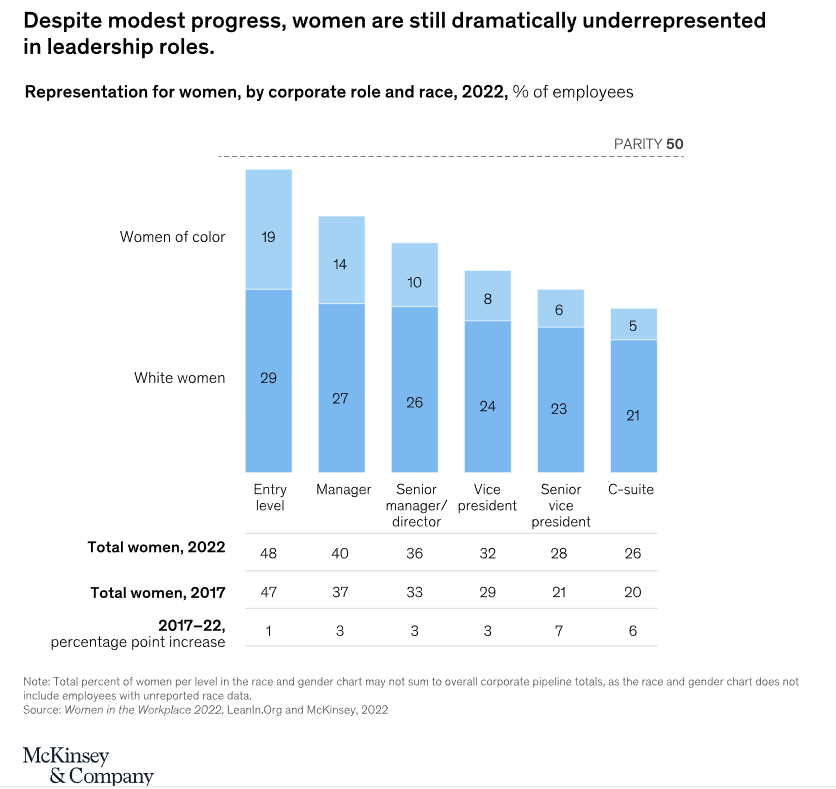Hello Friends!
Today’s newsletter is about something that is very close to my heart. A topic that I am very passionate about. A topic that thankfully even has its own month – but one that unfortunately needs its own month, as it isn’t something that is a topic for many people the other 11 months of the year.
That topic is The Other 50%.
And by that I mean, of course, Women.
Women make up 50% of the world’s population, but it is shocking how little power, venture capital, leadership positions, status, influence and control over their own lives most women have. I am not an expert on all the statistics, but it is a subject I think we need to pay closer attention to. All of us, men as well as women.
So let’s dive into it!!
WHERE WE ARE…
For the past eight years, McKinsey has conducted research into Women in the Workplace and they publish an annual report. It is always eye-opening reading. This year, McKinsey “collected information from 333 participating organizations employing more than 12 million people, surveyed more than 40,000 employees, and conducted interviews with women of diverse identities – including women of color, LGBTQ+ women, and women with disabilities – to get an intersectional look at biases and barriers.”
Despite “knowing” that there is a disparity in the workforce for women – that women are not achieving the level of leadership that men are – it’s one thing to “know” it, and another to have it smack you in the face. This Infographic is pretty telling:

That little note in the top right corner makes me sad – “Parity 50”. Like we all actually need to be told that to have equality, women would need to make up 50% of those graphs. That fact – that parity = 50 – isn’t even an axiom we all already know.
“Women leaders are just as ambitious as men, but at many companies, they face headwinds that signal it will be harder to advance. They’re more likely to experience belittling microaggressions, such as having their judgment questioned or being mistaken for someone more junior. They’re doing more to support employee well-being and foster inclusion, but this critical work is spreading them thin and going mostly unrewarded. And finally, it’s increasingly important to women leaders that they work for companies that prioritize flexibility, employee well-being, and diversity, equity, and inclusion (DEI).
If companies don’t take action, they risk losing not only their current women leaders but also the next generation of women leaders. Young women are even more ambitious and place a higher premium on working in an equitable, supportive, and inclusive workplace. They’re watching senior women leave for better opportunities, and they’re prepared to do the same.”
On a personal note, I can attest that over 25% of the female executives that I have coached have left their current role after having coaching. The goal of the coaching has never been to leave their company [in fact, quite the opposite], but through coaching these incredible women have realized that they are significantly undervalued in their companies, and choose to go elsewhere. My sample size is not as large as McKinsey’s, but the action is the same.

Even more shocking was seeing The Zero Report. In only one year, women’s representation in Pipeline to Senior Management roles has dropped 12%. 12%!! This is such a clear sign that this is not an individual problem, but truly a systemic one. A decline of 12% has nothing to do with women needing to be more confident or lean in more. It has everything to do with a system that is not set up for women to succeed.
WHAT THIS MEANS…
March 14th was Equal Pay Day. Equal Pay Day “represents how far into the year women have had to work to catch up to what their male colleagues earned the previous year. In other words, women have to work nearly 15 months to earn what men make in 12 months.”
Women aren’t advancing at the same rate as men. Women aren’t paid the same for the same work as men. And female business founders also receive only 2% of venture capital funds. As Cherie Blair so succinctly put it:
“2% is not a strategy, 2% is an accounting error. That’s just a mistake. Somehow, somehow or other, 2% got through. And yet the people who give venture capital are supposed to be the most sophisticated investors in the world. If they really read and understood the research, they should be giving 50% to women.”
This quote was taken from the absolutely brilliant Story of Woman podcast, in an episode where Cherie Blair and Hillary Rodham Clinton (who are friends in real life!) discuss how beneficial it is for everyone – men included!! – when women have equal rights and power to men.


WHERE WE NEED TO GO…
There are a few common themes in terms of taking action to address and redress this situation. One of them is that women need to stop being asked and expected to take on the (almost always) unpaid and unappreciated non-promotable tasks at work. Things like organizing the office party, or even many DEI topics. What gets paid for gets noticed. What gets noticed gets appreciated. And what gets appreciated advances your career. A good listen on this topic is The Long and the Short of It’s podcast on “The No Club: Putting a Stop to Women’s Dead-End Work.”
Another theme is to stop telling women to be more like men to get ahead. It doesn’t work. One oft-touted trope is that women should be more confident. First off, confidence is actually a feeling – not an action. And secondly, “While confidence is an ostensibly gender-neutral concept, our research found that confidence is not just gendered — it’s weaponized against women. When women fail to achieve career goals, leaders are prone to attribute it to a lack of self-confidence. And when women demonstrate high levels of confidence through behaviors, such as being extroverted or assertive, they risk overdoing it and, ironically, being perceived as lacking confidence.”
This article in the Harvard Business Review spells out just how harmful this “be more confident” trope is, and how it has been weaponized against women.
WOMEN’S FINANCES…
According to Statistics Canada, women have 18% less retirement income than men. That’s almost 1/5th less!! And given that women statistically live at least 5 years longer than men, this means they have to make that smaller sum work for them for even longer.
Just this morning as I was writing this newsletter, a friend sent me this article on Financial self-reliance: The 5 most common mistakes women make. The article is in German, but the concepts are relevant to all.
The five most common mistakes are:
1. Looking for the mistake in oneself
2. Giving the subject of money a wide berth
3. Submitting to the circumstances
4. Starting to invest too late
5. No separation of money and love
Perhaps by knowing about, and therefore avoiding these five mistakes, maybe more women will have parity in their retirement income!
HOW TO BE AN ALLY…
I am so curious to know how many male readers of this newsletter have actually read this far? And what your thoughts are if you have?
In order for women to have even a chance of achieving parity, we need male allies. The system is not going to change without them. How can you, as a man, be an ally to women? There were some really practical and easily applicable ideas recently for International Women’s Day, including this list of 10 things you could be doing as a man:
- Survey your female colleagues
- Show your appreciation
- Educate yourself
- Tell your female colleagues what a good job they’re doing
- Read our IWD Research on the Things People Say
- Call out bad behaviour
- Be more vulnerable
- Take primary or equal care responsibilities
- Buy a gift for your daughter, niece or goddaughter
- Become an agent of change
And my friend Julie made an incredibly powerful, impactful and real video on Not All Men – This Ends Now that I urge everyone to watch!
READ THESE!
Last but not least, if you want to dig a little deeper into this topic, I can highly recommend these two books. Both are incredibly informative and excellent sources of research and fact-based data on the topic of women’s inequality:
Invisible Women by Caroline Criado Perez.
There is also a magnificent podcast by the author on this topic that I highly recommend:
Visible Women podcast
The Authority Gap by Mary Ann Sieghart.
WHAT I’M READING!
I had Covid the last two weeks. It hit me HARD. I was completely flattened. Which meant that I wasn’t able to do anything at all. Not even read!! 😱 Once I was finally on the mend, I wanted to read something fun. Something engaging. Something that would have me turning the pages and completely sucked into the story.
How to Kill Your Family by Bella Mackie was absolutely it!! It was such a great story!! Okay yes, it was indeed about someone killing off her family, but it wasn’t gruesome or even really very dark. It was almost like a reverse detective story. We already know who did it, and why. We get to follow along with the protagonist (and let’s be frank – the murderer) as she decides who to kill, in what order, how, and why. As she lays out her motives, it starts making a lot of sense. It was really funny and light and enjoyable!! Maybe that makes me a psychopath?! Given that this book is on the Sunday Times bestseller list, at least I’m not alone! And in a weird way this book fits with the theme of the newsletter – it’s a strong woman creating her own destiny! 😉

Please do let me know your thoughts on this newsletter! It’s a topic I am passionate about, and would love to know your thoughts as well!
Wishing you a sunny, happy, and healthy week ahead!
Be emotional. Stay healthy.
Hugs,



